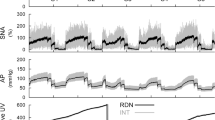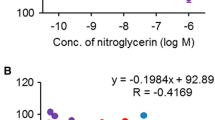Summary
Studies were carried out in 39 barbiturate-anesthetized dogs to determine whether the renin-angiotensin system is important in control of hemodynamics and coronary flow during myocardial ischemia. Plasma renin activity (PRA) was 2.2±0.4 ng·ml−1·hr−1 immediately before coronary artery occlusion (CAO) and increased to 3.8±0.5 (p<.005) 15 minutes after CAO. In nephrectomized dogs, PRA was 0.76±0.14 ng·ml−1·hr−1 two hours after nephrectomy and remained unchanged after CAO. In contrast, hemodynamic changes following CAO were similar between nephrectomized and intact dogs: mean arterial pressure fell from 126±4 pre CAO to 116±4 mm Hg post CAO (p<0.005) in nephrectomized dogs and from 130±11 to 120±11 mm Hg (p<0.005) in intact dogs. Left atrial pressure rose from 5.4±0.9 pre CAO to 7.7±0.9 mm Hg (p<0.005) post CAO in nephrectomized dogs and 6.3±1.3 to 9.0±1.8 mm Hg (p<0.005) in intact dogs. Heart rate remained unchanged in both groups. In sham-operated dogs without CAO, neither the angiotensin II blocker Saralasin nor the converting enzyme inhibitor Captopril had significant effects on systemic (SVR) and coronary (CVR) vascular resistances. In contrast, in dogs with CAO, these drugs reduced CVR from 1.28±0.13 mm Hg·ml−1·min·100 g heart weight (resistance units=RU) to 0.85±0.08 RU (p<0.05) (Saralasin) 15 minutes after treatment and from 1.17±0.09 to 0.88±0.08 RU (p<0.025), (Captopril) respectively. However, only Captopril reduced SVR, from 10.7±1.13 to 8.2±0.8 RU (p<0.025). Both Captopril and Saralasin induced a significant increase in collateral blood flow. Nephrectomy, two hours prior to CAO, significantly reduced the effect of Captopril on CVR and collateral blood flow while the effect on SVR persisted. Thus the reduction in CVR appears to be an effect of inhibition of the renin-angiotensin system; this system participates in control of CVR during CAO and may limit coronary collateral blood flow.
Similar content being viewed by others
References
Alexander, R. W., K. M. Kent, J. J. Pisano, H. R. Kaiser, T. Cooper: Regulation of postocclusive hyperemia by endogenously synthesized prostaglandins in the dog heart. J. Clin. Invest.55, 1175–1181 (1975).
Ammons, W. S., H. L. Santiesteban, S. Koyama, J. Manning: Carotid baroreflex regulation of plasma renin levels. Amer. J. Physiol.239, H342-H348 (1980).
Caldicott, J. H., N. K. Hollenberg: Offset of actions of angiotensin II, angiotensin III, and their analogue antagonists in renal and femoral vascular beds: further evidence for different vascular angiotensin receptors. Life Sci.24, 503–512 (1979).
Castellion, A. W., R. W. Fulton: Preclinical pharmacology of saralasin. Kidney Int.15, S11-S19 (1979).
Daniell, H. B., J. G. Webb, P. J. Privitera: Studies of the interrelationship between plasma norepinephrine, plasma renin activity and acute myocardial infarction in dogs. Res. Commun. Chem. Pathol. Pharmacol.20, 289–302 (1978).
Davis, J. O.: The use of blocking agents to define the functions of the renin-angiotensin system. Clin. Sci. Mol. Med.48, 3s-14s (1975).
Davis J. O., R. H. Freeman: Mechanisms regulating renin release. Physiol. Rev.56, 1–56 (1976).
Emanuel, R., J. P. Cain: Double antibody radioimmunoassay of renin activity and angiotensin II in humans. Lab. Clin. Med.81, 632–640 (1973).
Ertl, G., R. A. Kloner, R. W. Alexander, E. Braunwald: Limitation of experimental infarct size by angiotensin converting enzyme inhibitor. Circulation65, 40–48 (1982).
Ertl, G., R. A. Kloner, R. W. Alexander, E. Braunwald: Verkleinerung des Myokardinfarktes durch Substanzen, die das Renin-Angiotensin-System hemmen (Abstract). Z. Kardiol.70, 316 (1981).
Felder, R. B., M. D. Thames: Interaction between cardiac receptors and sinoaortic baroreceptors in the control of efferent cardiac sympathetic nerve activity during myocardial ischemia in dogs. Circulat. Res.45, 728–736 (1979).
Gavras, H., I. Gavras, H. R. Brunner, C.-S. Liang: Physiologic studies with saralasin in animals. Kidney Int.15, S20-S28 (1979).
Gavras, H., C.-S. Liang, H. R. Brunner: Redistribution of regional blood flow after inhibition of the angiotensin-converting enzyme. Circulat. Res.43, I-59—I-63 (1978).
Gerber, J. G., R. T. Keller, A. S. Nies: Prostaglandins and renin release. The effect of PGI2, PGE2, and 13,14-dihydro PGE2 on the baroreceptor mechanism of renin release in the dog. Circulat. Res.44, 796–799 (1979).
Glogar, D., G. Ertl, R. A. Kloner, J. R. Darsee, L. W. V. DeBoer: Coronary collateral flow in relationship to coronary bed size. Clin. Res. (Abstract)28, 174A (1980).
Heyman, M. A., B. D. Payne, J. I. E. Hoffman, A. M. Rudolf: Blood flow measurements with radionuclide-labeled particles. Progr. Cardiovasc. Dis.20, 55–79 (1977).
Hummerich, W., H. Feltkamp, A. Konrads, P. Ahlmann, H. Bornhofen: Reninactivation by kallikrein: evidence for alkaline-activation of plasma renin. Europ. J. Clin. Invest.9, 447–449 (1979).
Hutchinson, J. S., F. A. Mendelsohn, A. E. Doyle: Hypotensive action of captopril and saralasin in intact and anephric spontaneously hypertensive rats. Hypertension2, 119–124 (1980).
Johnson, J. A., J. O. Davis: Effects of a specific competitive antagonist of angiotensin II on arterial pressure and adrenal steroid secretion in dogs. Circulat. Res.32 and33 (suppl. I), I-159—I-168 (1973).
Johnson, J. A., J. O. Davis, W. S. Spielman, R. H. Freeman: The role of the renin-angiotensin system in experimental renal hypertension in dogs. Proc. Soc. Exp. Biol. Med.147, 387–391 (1974).
Kimura, E., K. Hashimoto, S. Furukawa, H. Hayakawa: Changes in bradykinin level in coronary sinus blood after experimental occlusion of a coronary artery. Amer. Heart J.85, 635–647 (1973).
Kloner, R. A., K. A. Reimer, R. B. Jennings: Distribution of coronary collateral flow in acute myocardial ischemic injury: effect of propranolol. Cardiovasc. Res.10, 81–90 (1976).
Lammermant, J., P. Dehert, C. DeSchryver: Direct release of catecholamines into the left heart chamber. The enhancing effect of acute coronary occlusion. Arch. Int. Pharmacol.163, 219–266 (1966).
Liang, C.-S., H. Gavras, W. B. Hood: Renin-Angiotensin system inhibition in conscious sodium-depleted dogs. Effect of systemic and coronary hemodynamics. J. Clin. Invest.62, 874–883 (1978).
Lionat, A., J. E. Zehr: Acute inhibition of renin release during left circumflex coronary occlusion in dogs. Amer. J. Physiol.242, H107-H112 (1982).
Meerbaum, S., T.-W. Lang, E. Corday, S. Rubins, S. Hirose, C. Constantini, H. Gold, M. Dalmastro: Progressive alteration of cardiac hemodynamics and regional metabolic function after acute coronary occlusion. Amer. J. Cardiol.33, 60–68 (1974).
Miller, E. D., A. J. Samuels, E. Haber, A. C. Barger: Inhibition of angiotensin conversion in experimental renovascular hypertension. Science117, 1108–1109 (1972).
Murphy, V. S., T. L. Waldorn, M. E. Goldberg: The mechanism of bradykinin potentiation after inhibition of angiotensin-converting enzyme by SQ 14,225 in conscious rabbits. Circulat. Res.43, (suppl. I), I-40—I-45 (1978).
Patterson, R. E., E. S. Kirk: Apparent improvement in canine collateral myocardial blood flow during vasodilatation depends on criteria used to identify ischemic myocardium. Circulat. Res.47, 108–116 (1980).
Reimer, K. A., R. B. Jennings: The “wavefront phenomenon” of myocardial cell death. II. Transmural progression of necrosis within the framework of ischemic bed size (myocardium at risk) and collateral flow. Lab. Invest.40, 633–644 (1979).
Richardson, J. A., E. F. Woods, E. E. Bagwell: Circulating epinephrine and norepinephrine in coronary occlusion. Amer. J. Cardiol.5, 613–618 (1960).
Russell, R. A., J. Craford, A. S. Harris: Changes in myocardial composition after coronary artery ligation. Amer. J. Physiol.200, 995–998 (1961).
Seymour, A. A., J. E. Zehr: Influence of renal prostaglandin synthesis on renin control mechanisms in the dog. Circulat. Res.45, 13–25 (1979).
Thames, M. D., M. Jarecki, D. E. Donald: Neural control of renin secretion in anesthetized dogs. Interaction of cardiopulmonary and carotid baroreceptors. Circulat. Res.42, 237–245 (1978).
Thames, M. D., H. S. Klopfenstein, F. M. Abboud, A. L. Mark, J. W. Walker: Preferential distribution of inhibitory cardiac receptors with vagal afferents to the infero-posterior wall of the left ventricle activated during coronary occlusion in the dog. Circulat. Res.43, 512–519 (1978).
Thurston, H., J. D. Swates: Blood pressure presponse of nephrectomized hypertensive rats to converting enzyme inhibition: evidence for persistent vascular renin activity. Clin. Sci. Mol. Med.52, 299–304 (1977).
Author information
Authors and Affiliations
Additional information
Supported by Grant er 100/1 of the DFG and by Grants HL-23140 and HL-26215 from the National Heart, Lung, and Blood Institute, USA.
Rights and permissions
About this article
Cite this article
Ertl, G., Alexander, R.W. & Kloner, R.A. Interactions between coronary occlusion and the renin-angiotensin system in the dog. Basic Res Cardiol 78, 518–533 (1983). https://doi.org/10.1007/BF01906463
Received:
Issue Date:
DOI: https://doi.org/10.1007/BF01906463




